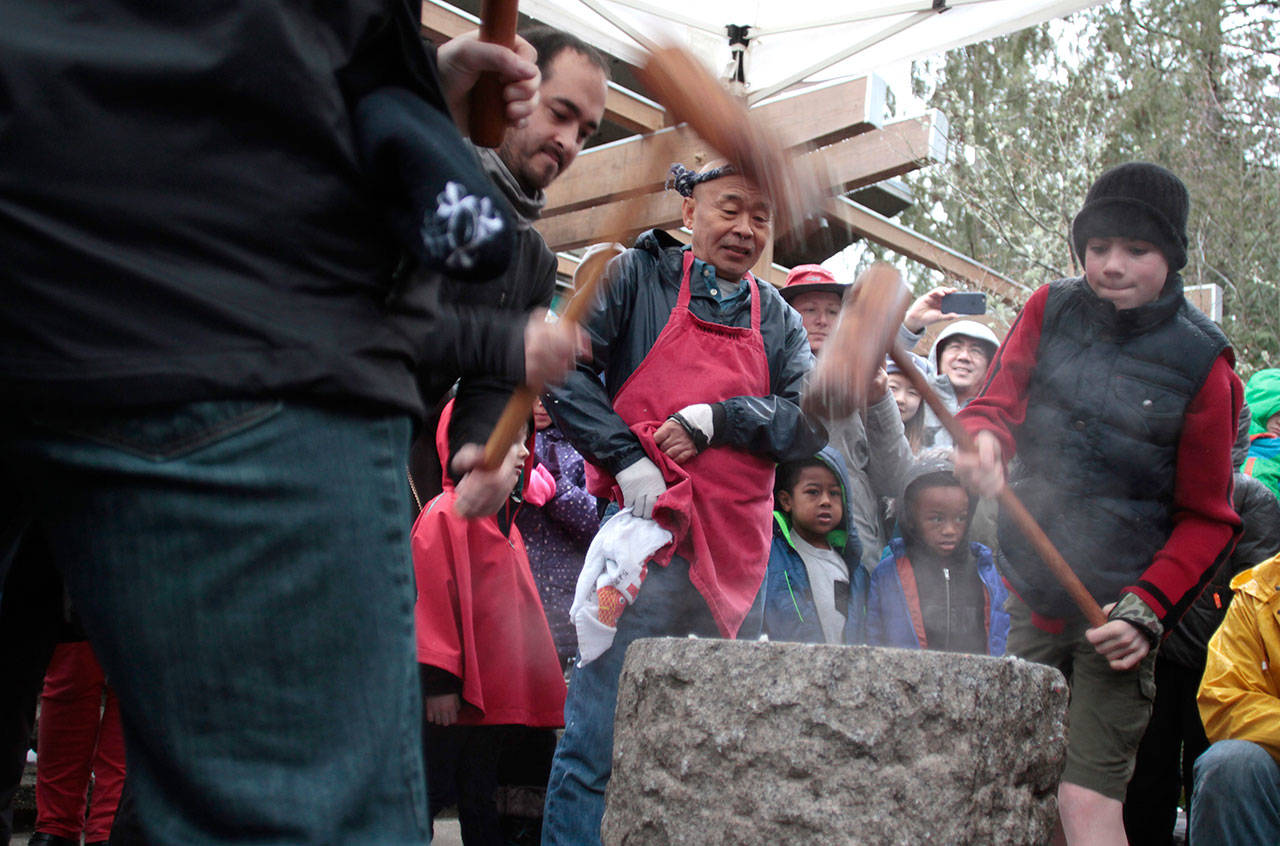This year marks the 30th anniversary of the now-iconic Bainbridge Island mochi tsuki event, reportedly the largest of its kind in the country.
The traditional Japanese gathering will this year be held at a new, larger location, at Woodward Middle School (9125 Sportsman Club Road NE), from 11 a.m. to 3 p.m. Saturday, Jan. 5.
According to the Bainbridge Island Japanese American Community, longtime hosts and facilitators of the event, besides the new location perhaps the most noteworthy change to this year’s gathering is that no tickets will be required for entry — or for the popular Seattle Kokon Taiko performances.
The two shows of the award-winning drum ensemble will be held in Woodward Middle School’s spacious gymnasium for the first 500 guests in line, first from noon to 12:30 p.m. and then from 2 to 2:30 p.m.
While parking is available in the school’s main lot, and also at nearby Sakai Intermediate School, carpooling is still strongly recommended.
The event remains free, and all guests will receive a special 30th anniversary commemorative gift as a token of BIJAC’s appreciation for the decades of community support and attendance.
“For the past 15 years, IslandWood has been a wonderfully generous partner hosting our mochi tsuki celebration,” said Clarence Moriwaki, BIJAC president.
“Indeed, without their support throughout all of these years, we would not have grown into what may be the largest public mochi tsuki event in the country, and we’re forever grateful for their community spirit and friendship,” he added.
The gathering began as a small New Year’s celebration at the former Bainbridge Dry Cleaner located on lower Winslow Way. The celebration quickly grew in popularity and moved to Island Center Hall, but after a few years the event grew even bigger and moved again to the Filipino American Community Hall. In 2004, IslandWood hosted their first Mochi Tsuki celebration, where the event has been held every year since.
Traditional mochi pounding, hand forming mochi, origami folding and a new BIJAC history game with prizes will be featured, along with displays of the award-winning “Kodomo No Tameni – For the Sake of the Children” exhibit of 100 years of Japanese American history on Bainbridge Island, and plans for future phases of the Bainbridge Island Japanese American Exclusion Memorial.
The new move to Woodward Middle School is made possible, Moriwaki said, thanks to a cultural grant from the city of Bainbridge Island and support from event partners Town & Country Market, Bainbridge Island ACE Hardware and IslandWood.
For the next two years at least, officials said, BIJAC is planning to host Mochi Tsuki at Woodward, and will strive to keep the event free and open to the public.
For more than a millennium, making and eating the sweet rice treat mochi has been a celebrated New Year’s tradition in Japan, with generations of families and communities coming together to wish good health and prosperity for the new year.
BIJAC members will prepare some batches of mochi in the centuries-old method of first steaming the sweet rice over an open fire, then placing the cooked rice into a warm stone or concrete bowl called an usu. Using large wooden mallets, two people rhythmically pound the rice in the usu, while with bare hands a third person swiftly moves the rice between each mallet crash.
After several minutes of vigorous pounding, the rice becomes a thick, smooth dough — mochi. From manual pounding in the usu or special mochi-making appliances, the mochi is removed and children of all ages hand form the steaming-hot mochi into small handball-sized cakes, filling some of them with a sweet bean paste called ahn.
While arguably mochi is best eaten hot and fresh, many enjoy roasting it in the oven, then dipping the puffy and crisp hot mochi cakes into a combination of sugar and soy sauce. For future enjoyment, mochi can be frozen in airtight bags.
For more information, visit www.bijacevents.org.



